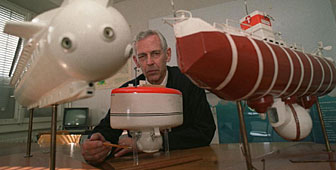Piccard’s submarine berths in Lucerne

A legendary diving vessel, which took 33,000 people to the bottom of Lake Geneva in 1964, is to take pride of place at the Swiss Transport Museum.
Invented by Swiss scientist Auguste Piccard, the mésoscaphe was the first submarine to carry tourists and made more than a thousand dives.
The museum in Lucerne will finance the transport and renovation of the rusting submersible, which was displayed in mint condition at the Swiss national exhibition in 1964 and was last seen at Expo.02.
Built by Piccard’s son Jacques, the submersible was the great attraction of the 1964 national exhibition in Lausanne. Even though it almost never made it.
From Expo 64…
Jacques Piccard, who four years earlier had set the record for the deepest ever ocean dive (10,914m) with his bathyscaphe “Trieste”, proposed his mésoscaphe project to the board of Expo 64. They were initially enthusiastic.
But just as the prototype was about to be completed, the organisers got cold feet about passenger safety.
Because he didn’t have a degree in engineering, Jacques Piccard was removed from the project.
The mésoscaphe eventually started its tourist dives two-and-a-half months after the opening of the Expo – and without its creator.
The submersible then floated in seas all around the world – travelling to Canada, Colombia, Mexico and the United States – before being brought home to Switzerland at the end of the 1990s by the Auguste Piccard Mésoscaphe Association, which has since become its owner.
…to Expo.02
In 2002 the mésoscaphe reappeared on the exhibition site at Murten next to Jean Nouvel’s Monolith.
Jacques Piccard saw his latest project rejected by the Expo.02 board – he had wanted to take guests down into the depths of Lake Neuchâtel on board automatic mini-submarines.
The oceanographer eventually had to content himself with watching his submarine grounded on the banks of Lake Murten. All rusty, the mésoscaphe had become the symbol of fleeting success, illustrating the theme of the venue: “The Moment and Eternity”.
After Expo.02 the mésoscaphe was taken to an industrial park in Villeneuve, on Lake Geneva, where it was put in storage, dreaming no doubt of one day regaining its beautiful white shell.
Lucky Lucerne
Several locations offered to accommodate the legendary submarine. Apart from the Lucerne museum, most of them were situated on the shores of Lake Geneva, notably at Bouveret, Lausanne and Nyon.
Earlier this week, the Auguste Piccard Mésoscaphe Association chose Lucerne.
“The museum has agreed to finance the transport and renovation of the machine,” said Christian Savioz, the president of the association.
It has suggested that unemployed people could be paid by job centres to renovate the exterior of the submarine. Discussions are currently underway with the museum and a decision is expected at the end of August.
The renovation of the submarine’s exterior could take 18 months. The work will take place at the factory of the now-bankrupt Giovanola company, where the submarine was built in the 1960s.
The mésoscaphe weighs 140 metric tons and is 28m long and 7m high.
It cost SFr7.3 million ($5.6 million) to build.
Its renovation is estimated at almost SFr1 million.
In 1960 Jacques Piccard and Donald Walsh set the record for the deepest ever ocean dive (10,914m) in the South Pacific’s Marianas Trench.
Nicknamed “the deepest man in the world”, Jacques Piccard built the “Auguste Piccard” mésoscaphe, the first submarine for tourists.
At Switzerland’s national exhibition, Expo 64, the mésoscaphe took 33,000 guests below the waters of Lake Geneva.
The oceanographer also led an international expedition to study the Gulf Stream. He then devoted himself to studying the Swiss lakes.
Aged 83, Jacques Piccard – son of Auguste and father of balloonist Bertrand – remains “the deepest man in the world”.

In compliance with the JTI standards
More: SWI swissinfo.ch certified by the Journalism Trust Initiative












You can find an overview of ongoing debates with our journalists here . Please join us!
If you want to start a conversation about a topic raised in this article or want to report factual errors, email us at english@swissinfo.ch.